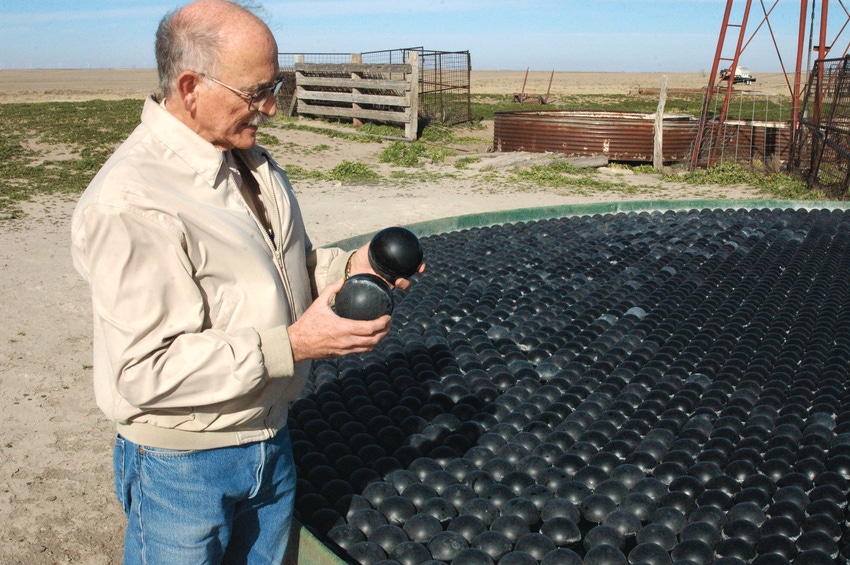Shade balls reduce evaporation, freezing and debris in cattle water tanks.
May 7, 2019

Water is a herd’s most precious nutrient. In the dry Southwest, it glitters more than gold — especially during drought. But some ranchers in eastern New Mexico and the Texas Panhandle think they’ve found a way to reduce evaporation and improve quality for their herds.
By covering a water tank’s surface with shade balls — plastic balls 4 inches in diameter — Mitzi and Dink Miller of Floyd, N.M., reduce evaporation by close to 75%. The layer of shade balls also reduces ice buildup. And they help scatter birds, which can ruin water quality with excessive droppings.
The Millers run an Angus seedstock operation on land they used to farm under pivot irrigation. Both were pilots for the New Mexico Department of Agriculture and ran a small flight school in between farming and ranching. Upon retirement, they devoted their full efforts to the Angus genetics business.
Miller Angus is in eastern New Mexico, outside of Floyd in Roosevelt County. The area gets barely 17 inches of precipitation in a good year — often closer to 7 inches. When drought sets in, water wells sometimes can’t keep up with cattle needs.
“We had observed work done by the Roosevelt Soil and Water Conservation District (SCWDO) with shade balls,” Mitzi says. “We gave it a try and liked our results.”
Numbers tell the tale
In 2015, the SWCD began conducting research with shade balls on livestock water tanks. The high-density polyethylene (HPDE) plastic balls are 4 inches in diameter, UV-stable and partially filled with water to prevent being blown away.
To achieve high surface-area coverage, balls are placed in sufficient number to cover up to 91% of the water surface. The SWCD office notes, “We have recorded significantly less evaporation and ice formation with the ball-covered tank.”
For example, in a tank 7.5 feet in diameter that contained no shade balls, evaporation in excess of rainfall totaled more than 10,700 gallons over a three-year period. But for a 7.5-foot tank with shade balls, evaporation was only about 2,600 gallons.
For a 20-foot tank without shade balls, evaporation topped 81,000 gallons. That compares with fewer than 20,000 gallons of evaporation from a 20-foot tank with shade balls.
“We’ve seen similar results,” Mitzi says. “We put shade balls on one tank last summer, which was in the middle of an extreme drought. We didn’t have to haul water to that tank once.
“We now have four tanks with balls and plan to add more. We like what we’re seeing. Even if you save just a little more water, you can add more cows if there is grass for them.”
P.K. “Tip” Brian, who runs summer stockers on grass in Armstrong County, Texas, east of Amarillo, sees similar benefits. “I didn’t have to haul water last summer,” he says, describing his first year of using shade balls.
Brian runs various numbers of steers on flat rangeland during the summer. Like the Millers, he’s lucky to see 15 to 20 inches of precipitation a year. “I had read about shade balls and looked at the [SWCD] studies out of Portales, N.M.,” he says. “I added the balls to one 25-foot in diameter tank in March 2018.
“In 2017, I had hauled six loads of water to help supplement water from the windmill that feeds the tank. But last year, I only hauled one load, but that was early because I wanted to be safe and to stay out of mud if it rained in the spring.
“It didn’t rain at all most of the summer, and the balls prevented excessive evaporation.”
Less ice
Neither the Millers nor Brian have heated water tanks. Their region sees cold temperatures, but nothing like weather conditions farther north. Still, temperatures easily dive below freezing. The shade balls ease the burden of breaking ice.
“We were in the teens for a few nights in January,” Mitzi says. “We had to break ice on tanks without shade balls. But where we had shade balls, cattle were able to drink freely. There was little ice. That’s another big plus for the balls.”
What’s more, the shade keep the birds away. “Birds don’t like the balls,” Mitzi says. “They aren’t setting around pooping in and around the tanks, which can promote coccidiosis. The balls also hold down algae problems caused by blowing dirt and trash that can get in tanks.”
Consider the cost
Cost of the balls is about 60 cents each. To provide up to 91% coverage of an 8-foot tank, the county SWCD estimates that about 500 shade balls are needed. That jumps to 785 balls for a 10-foot tank and about 3,100 for a 20-foot tank. More than 4,900 are needed for a 25-foot tank.
The Millers are hoping the shade ball program’s success can lead to them be included in the USDA Environmental Quality Incentives Program, which provides federal subsidies to help pay for conservation improvements.
Brian plans to add shade balls to additional pastures. And he saw firsthand how the balls can handle a Panhandle wind. “When southwest winds were 25 to 30 mph and gusting past 45 mph in mid-February, not one ball was blown out of the tank,” he says.
When it comes to water for their cattle, anything to throw Mother Nature a curveball and stretch supplies suits Brian and the Millers just fine. Shade balls were just the pitch they needed.
Stalcup writes from Amarillo, Texas
Editor's note--For information on how to buy shade balls, contact Dawn Privett, Roosevelt SWCD, 575-356-6629 #3019 or 951-236-3732
About the Author(s)
You May Also Like



